Cold Climate Permaculture Plants: Hybrid Hazel
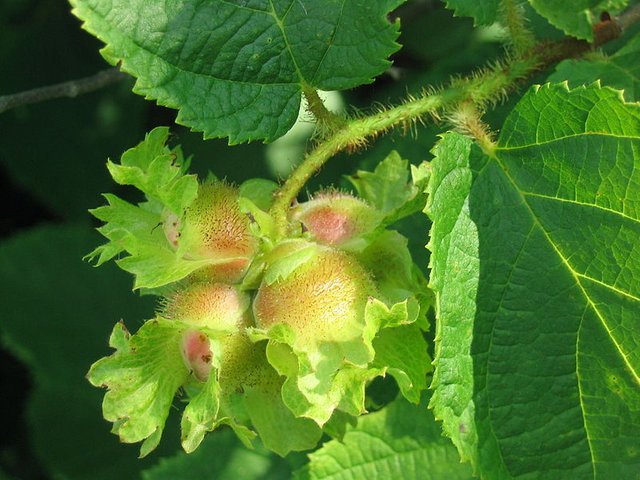 American Hazel / Source
American Hazel / SourceDescription
I am pretty sure most everyone reading this blog will be familiar with hazelnuts. They are one of the more popular nuts and are primarily used as food, either whole or as a flavoring for products like chocolate truffles or in coffee and spreads. What might be less well known is that hazels are a member of the birch family and have been cultivated by humans for over 8000 years!
The vast majority of hazelnuts are produced by a plant known as Common Hazel or European Hazel (Corylus avellana). This variety of hazel is primarily grown in Europe with Turkey producing over half of the worlds supply of hazelnuts.
In North America common hazelnuts are are primarily grown commercially in the states of Oregon and Washington because, unlike the Eastern half of the United States, this area was not yet affected by eastern filbert blight. Unfortunately, this blight has now reached these previously untouched areas and is starting to kill these commercially grown trees.
Enter the hybrid hazel. These hybrids are usually crosses between the American hazel (Corylus americana) and the common hazel. Some breeders have also used the beaked hazel (Corylus cornuta) as part of their crossing program. The American and beaked hazel both have significant resistance to eastern filbert blight and are more cold hardy but they produce nuts that are far too small for commercial production.
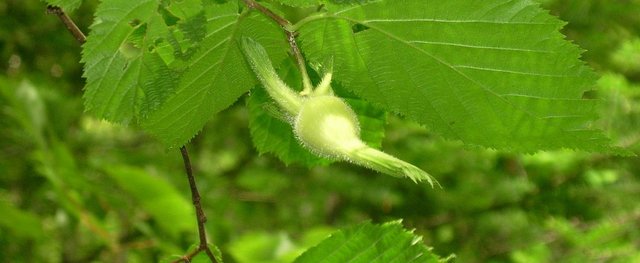 Beaked Hazel. / Source
Beaked Hazel. / SourceSignificant breeding work has been done on hybrid hazels by several different groups. Notably the Badgersett Research Corporation, Mark Shepard, Arbor Day Foundation and Rutgers University. However, there are many others working on this project as well.
The breeding has been focused to provide the best mix of attributes of both species. The primary objective has been to produce a hazel with eastern filbert blight resistance and increased cold hardiness while still maintaining a fairly large nut size. A secondary characteristic that they are breeding for is machine harvestablitity to increase the potential of these hazel hybrids being used as a commercial crop.
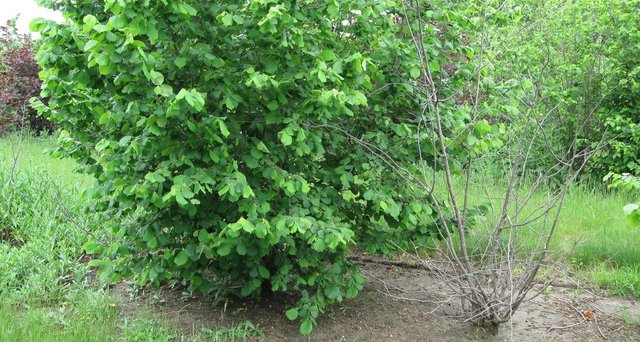 Eastern filbert blight resistant hazel next to non-resistant hazel. / Source
Eastern filbert blight resistant hazel next to non-resistant hazel. / SourceThe hybrid hazel is a medium to large shrub that grows from 10-16 feet tall and with a width of 5-8 feet. As mentioned earlier, it produces nuts similar although perhaps a bit smaller than common hazelnut. It has a dense fibrous root system with no tap root and the ability to thrive in a variety of conditions. A lot of the breeding has been done in Michigan which is known to have brutally cold winters. Due to this cold location, the hybrid hazel can usually be grown in zones 4-7 but, depending on the specific variety, zone 3 is also a possibility.
Uses
When people think of hazels they often focus on the nut. This tasty morsel, as motioned earlier, is used in a variety of food products. By dry weight. the nuts are generally 58% oil, 22% carbohydrate and 17% Protein. Although the source I found did not directly say it, I imagine the other 3% is mineral weight.
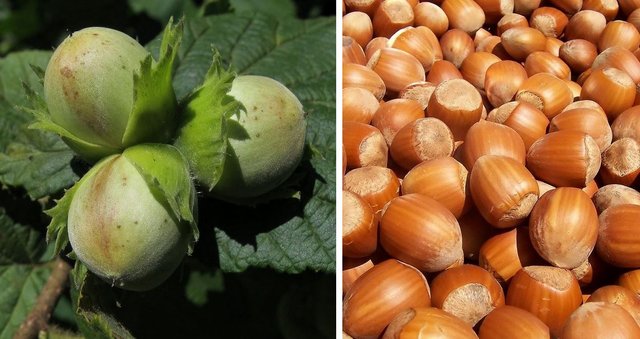 Hazelnuts / Source 1 / Source 2
Hazelnuts / Source 1 / Source 2This sort of nutritional profile makes hazelnuts very compelling as food for both humans and animals. Of particular interest is the oil content which some have suggested makes hybrid hazel a potential perennial replacement for soybean crops. Many sources are claiming that, once established, hazels can produce similar amounts of oil to soy on the same acreage with far fewer inputs.
Many other drawbacks of annual agriculture would also be reduced; little to no fertilizer and toxic sprays would be needed. One of the biggest environmental issues today, that is rarely spoken about in the mainstream, annual tillage, would also be eliminated.
The oil, once pressed from hazelnuts, is a great cooking or flavoring oil. Some have even suggested that it could also be used to make bio-diesel. The hazel meal left over from pressing can be used as a component of animal feed, boosting protein and carbohydrate.
Due to the dense fibrous root system, hazel hybrids also sequester carbon, particularly in the root system, while stabilizing the soil and preventing erosion. The above ground portion of the plant provides animal habitat and, if planted as a perimeter hedge, could act as a wind break.
After about ten years the above ground growth and nut production will slow but can be reinvigorated by coppicing. This makes hybrid hazel a great biomass crop as well. On a large scale it could be used to make bio fuel while on a smaller scale it could be used for firewood and mulch.
Growing Conditions, Propagation, and Maintenance
Hybrid hazels seem to be mainly propagated by seed but work is also being done with vegetative propagation. In the wild, American hazels often propagate by suckering and some hybrids are noted for this trait so there may be potential in this area. Seedlings can be planted in late spring to early summer and the best conditions to do so are cool and moist.
Hybrid hazels will produce the most in full sun but American hazel is a forest edge plant that does well in partial shade, therefore the potential of hybrid hazels to be grown in partial shade is favourable. Some sources also show reasonable nut production in partially shaded circumstances. Hybrid hazels do not need fertilizer but will likely produce a larger nut crop if fertilizer is used.
This is a very adaptable plant that will grow well in soils ranging from heavy clay to sandy silt. PH ranges from 5.5 to 8. Once established they may need as little as 20 inches of rain a year.
These plants are generally not bothered by disease or insect pest. Birds and mammals, like squirrels, can pose more of a problem because they are tempted by the tasty nuts, but as the size of the planting increases the percentage of nuts stolen decreases. Deer do not prefer hazel as a browse but can pose a problem to initial plantings; after a few years, as the plants get larger, they will do little damage. It also helps to keep the hazels far from forest edges and to keep the ground under them well trimmed. Human activity will also help to deter animal pests.
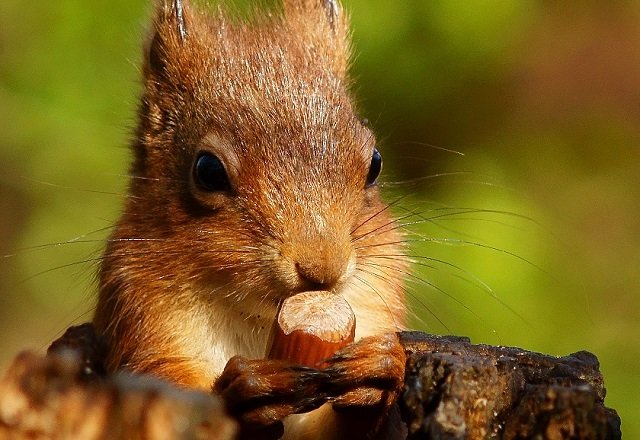
Hybrid hazels are monoecious which means they have male and female flowers on the same plant. The male flowers are catkins which open in the winter and flower into the spring. The female flowers are tiny and hard to spot. Pollination is almost exclusively by wind and it is important to have two or more varieties in close proximity as plants cannot pollinate themselves. This shouldn't be a problem if you are growing seedlings.
Over time, the hazel bushes may grow too large for your liking or become unproductive due to excessive old and dead wood. At this point, best practice is to coppice them to the ground. This will refresh and invigorate the plant. They will be back to full production in 2-3 years. The root system will probably live for 100 years or more.
Sources and Resources
There are a couple of good PDF's in here.
- https://www.extension.umn.edu/environment/agroforestry/components/hybrid-hazelnuts.pdf
- http://www.badgersett.com/sites/default/files/info/publications/HH1.pdf
- http://www.badgersett.com/info/hazelnuts
- https://en.wikipedia.org/wiki/Hazelnut
- https://en.wikipedia.org/wiki/Hazel
- https://www.sciencedirect.com/science/article/pii/S0926669009001393
- Ken Mudge and Steve Gabriel (2014). Farming the Woods. White River Junction, VT: Chelsea Green Publishing.

Once again Matthew, another awesome post. Thanks for all the hard work and research you have done.
It is becoming our go-to place to see what we should plant going forward coming to see what you're posting about.
What we would like to know is how are you finding these plants? Wouldn't it be great to put a source where we can get it? :D
Thanks, with the fact checking I have to do, these plant articles are my most time consuming posts.
I've been dreaming about my homestead and researching plants for many years so these plants are all plants I am either currently experimenting with or plan to in the future. I believe the Badgerset Research Corp. in the sources section sells nuts and seedling plugs.
You can also try Oikos Tree Crops or Grimo Nuts. There are probably more sources but I haven't looked in awhile. Mach sure to check growing zones on individual types as they can vary quite a bit.
Wow, again, thank you. We're going to have to spend some time researching.
We've been dreaming about our homestead too and how we're going to plot it, terrace, swales, ponds. It will be beautiful.
If it wasn't for dreamers like us we'd still be riding horses and throwing rocks.
I and my wife are planning on starting a homestead/permaculture farm here in Michigan soon. You are located in a similar climate and I think I am going to be able to learn a lot from your blog. Thank you for sharing.
We are just new on Steemit so You are the first article I have had the pleasure of reading.
Steve Bridges
I’m from Michigan myself. Very excited to see people joining the permaculture movement. My son @theferalone got me started on that path. He belongs to the homesteading server on Discord if you want to touch base. We go to a permaculture group on Meetup in the Grand Rapids area. You should check it out.
My husband and I bought an old blueberry farm about 4 years ago and have been implementing some organic and permacultural practices. Unfortunately he passed away about 4 months ago. I’ve decided to sell because it;s more than I can handle alone. We have a total of 29 acres. About 10 acres of blueberries, an open field and some pine forest. Would really love for it to go to someone who practices permaculture.
Thanks for reading! I am glad you think you will get some value from my blog. Feel free to comment or start up a conversation here any time and welcome to Steemit!
Matthew
We're about to do another bloodtest with my allergic kiddo. I'm hoping we've healed her gut enough that she can tolerate some variety of nuts. We were once playing in a friend's yard and the kids had been throwing some green walnuts around. We'd never seen walnuts in the green casing, so I didn't even think about it until her face started puffing up and I was giving her Benadryl ASAP! Luckily we've never had to use an Epi-pen.
Anyway, we really would like to grow some type of nut on the homestead and not worry about reactions if she accidentally touches it. Right now the only nut she can tolerate is almond, and I don't see many success stories of almonds in regions that get as cold as we do. I have had a few people recommend that she try hazelnuts as there tend to be less allergies to them than say pecans or walnuts.
Thanks for the super informative, but easy to read post! Two thumbs up!
I'm glad to hear that your daughter is showing some improvement. Fingers crossed that Hazel's will work for you.
My heritage is mostly Irish with a little Cherokee thrown in. In Cherokee tradition, hazel nuts were an important food source, but also used in medicine. Hazel nuts are also a part of Irish folklore. Sooooo, yeah. I like me some hazel nuts. :)
Hazel nuts have an extremely interesting history I would have liked to get into a bit more.
I love hazelnuts so much! Thank you for the great info on a topic I never really knew about. I will def check out the oil and see what its like to cook with. Have you used it> If so any tips on it that would help?
I haven't used hazelnut oil yet but I imagine it would impart a unique flavor.
I have only had hazelnuts whole or as part of some chocolates or other sweets. Oh and of course hazelnut coffee!
Ok love hazelnut coffee myself. When I try the oil I will share the results with you!
This is great. I'm going to ask our greenhouse guy if he can get a couple in. Are they hard to propagate?
I don't have any experience propagating Hazel's but I don't think they are any harder to propagate from cuttings then the average tree or bush. In my research I came across at least one nursery that was cloning a specific variety.
Also they might sucker a bit and they will grow back from the root if you coppice them so I think there should be an easy way to reproduce them other then by seed.
Oh cool. I want to get good at cloning and grafting before it's necessary. I've had a bit of success with haskaps and gooseberries and this year I will try layering them.
Good for you! There is no excuse to not be working on your skillz!
i didn't know about hazelnuts before. you told that it will grow too large... it's quite interesting... i'll search for it. btw thanks for the info sir.👍
You are welcome. Thanks for reading!
Never heard of hazelnut oil before, let alone hazelnut bio-diesel. Diesel could then sound delicious. Is the hazelnut oil sold commercially? If it is, I think it's worth a try. It's like cooking your food in an auto-hazelnut flavor. 😊 Thank you for sharing. See you around.
Hazelnut oil is available, but right now it is considered a specialty oil and is expensive!
Maybe that's why we don't have it here yet. 😀 But it's still worth a try. Hopefully when it gets available in the Philippine market. 😊Cheers!
We were contemplating growing hazlenuts as a border crop to help keep the forest from advancing on our field. We’re selling the farm now but wherever I go would still like to make this a part of my plan.
Thanks for the info. Very well done.
You're welcome! Wish you success with your future endeavors.
Great information on the hazelnut! I don’t know what variety they were, but we had an entire hedge row where I grew up. The hedge had hazelnuts and Concord grapes intertwined with them. Both incredibly delicious. My parents are both from New Brunswick near the Mirimichi river. Spent every summer up there growing up. Salmon and trout fishing! Beautiful!
Your description reminds me of one of my first cousins up there.
Any way! Enjoyed!
Interesting, my favorite grapes are concord grapes! Were the nuts a decent size or were they the small wild type?
Thanks for reading!
Concord grapes have that taste that makes me say mmmm, ever time, I would say the nuts were about 1/2 inch in diameter average.
Ok, probably American or beaked hazel then with the smaller nuts. Or did you mean the diameter of the shelled nut?
Diameter with the shell! Grapes and nuts. Can’t go wrong with that!
An excellent article. I read the Badgersett book on their work on what they call neo-hybrid hazelnuts recently and it was good to see you recommend many of the same things. I will be looking forward to any other articles you write.
Thanks! I noticed you commented on another thread in this comments section. I have not read that book yet but it sounds right up my alley. Is this it?
https://www.chelseagreen.com/product/growing-hybrid-hazelnuts/